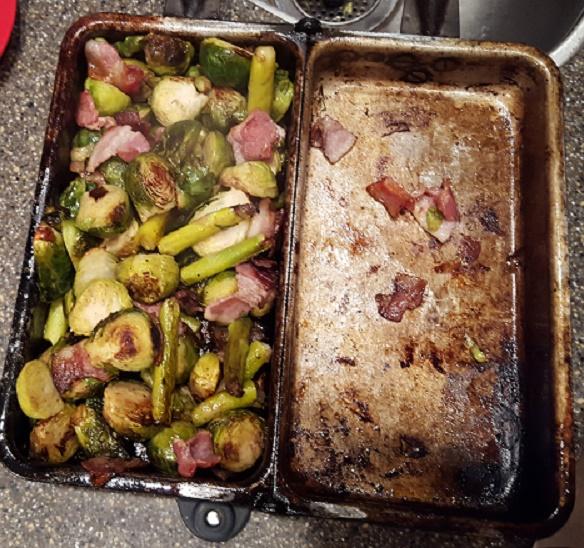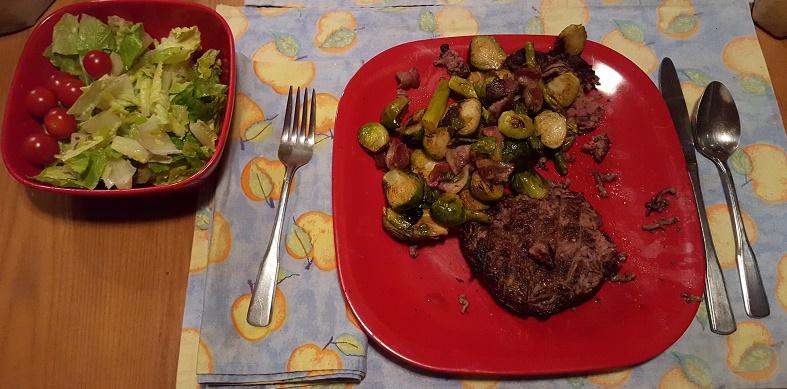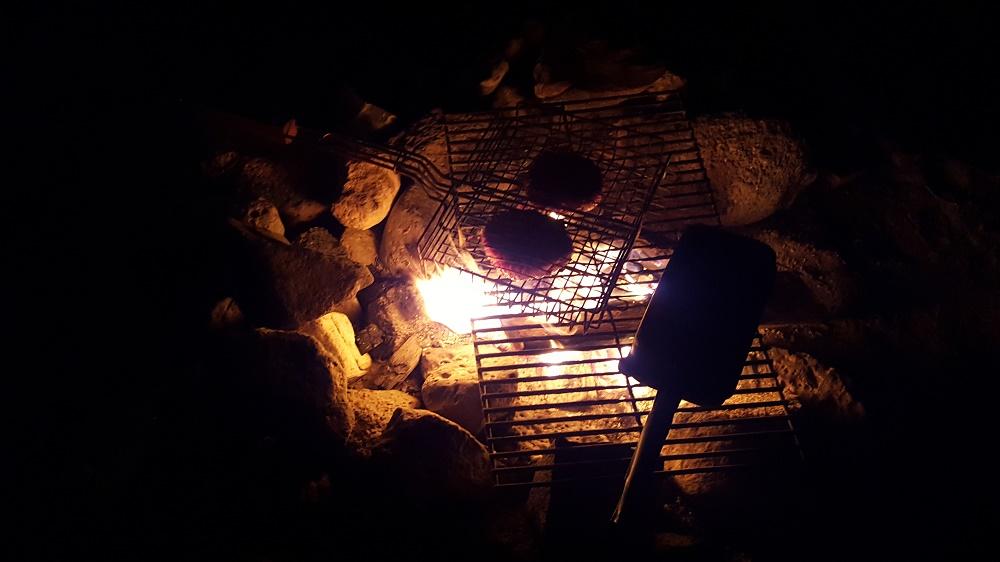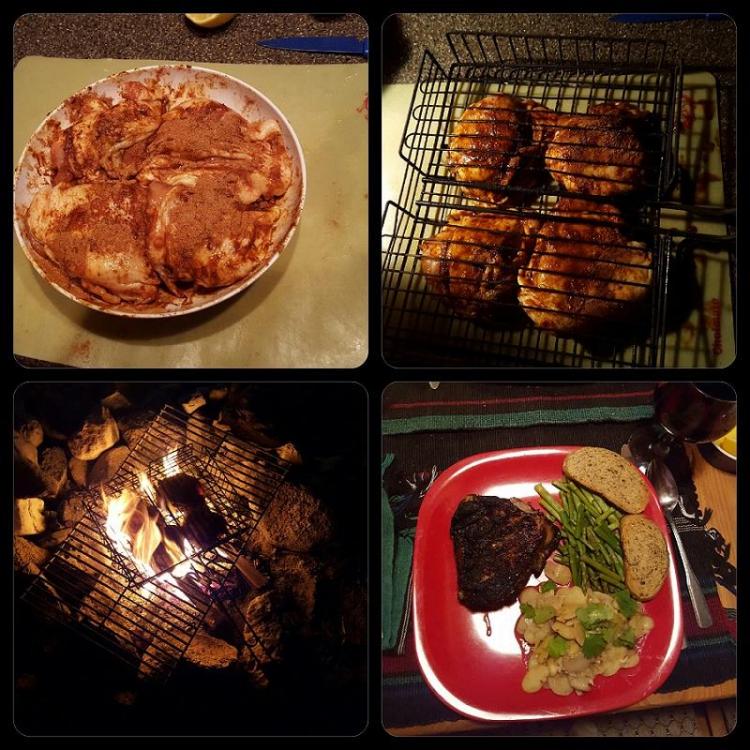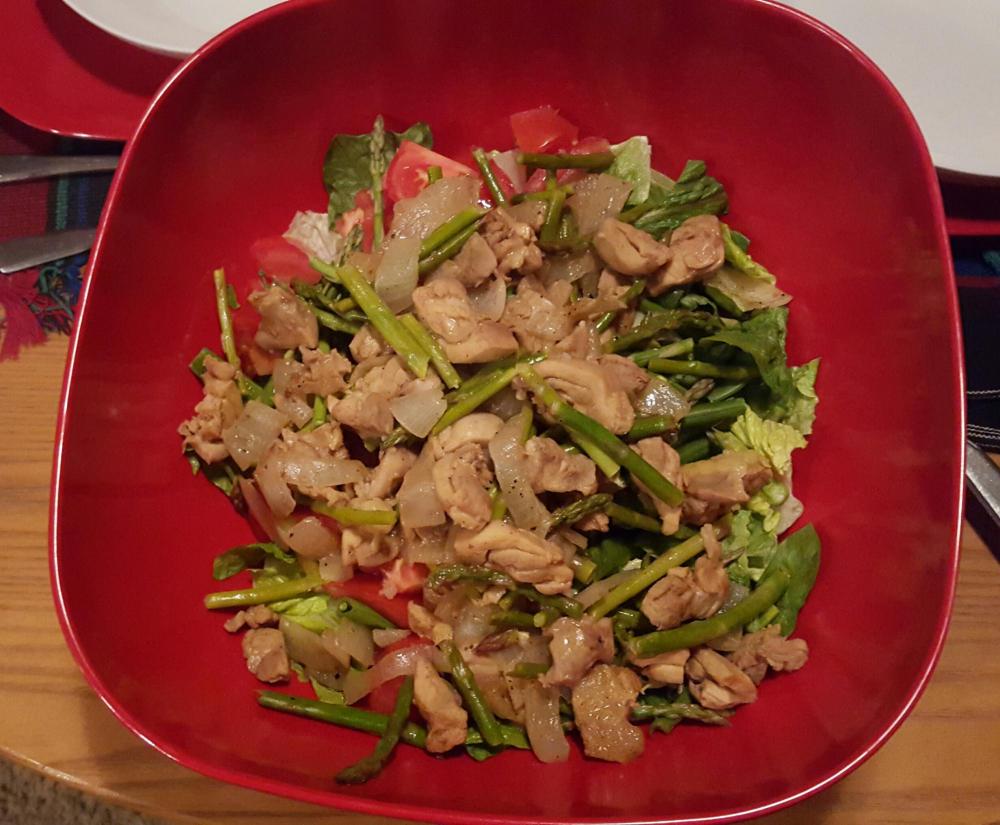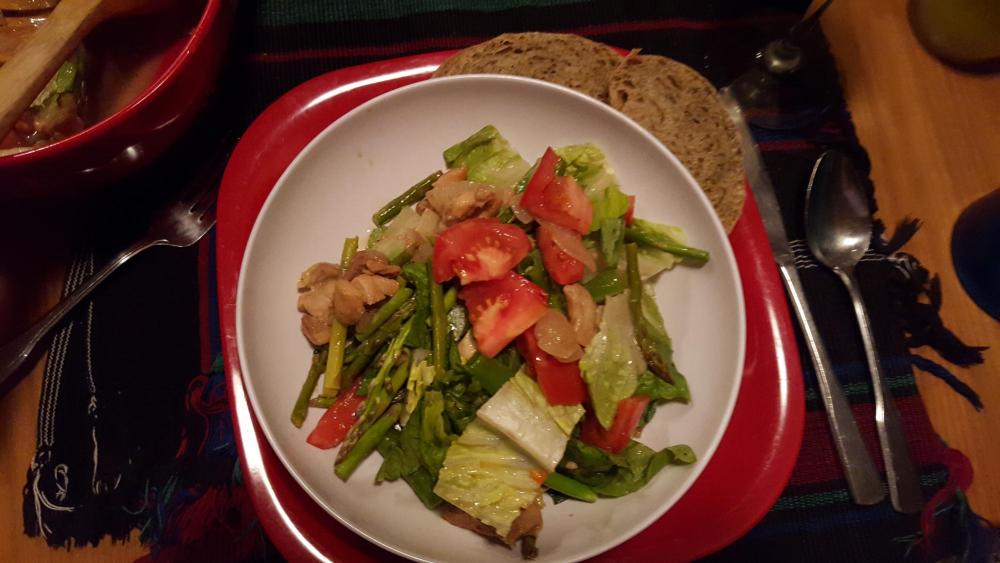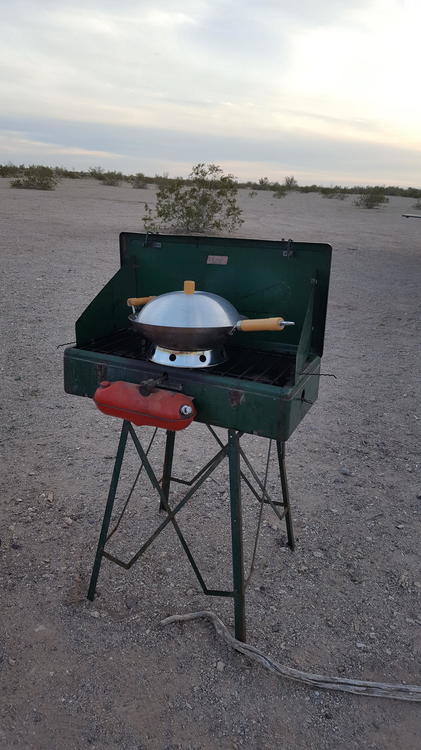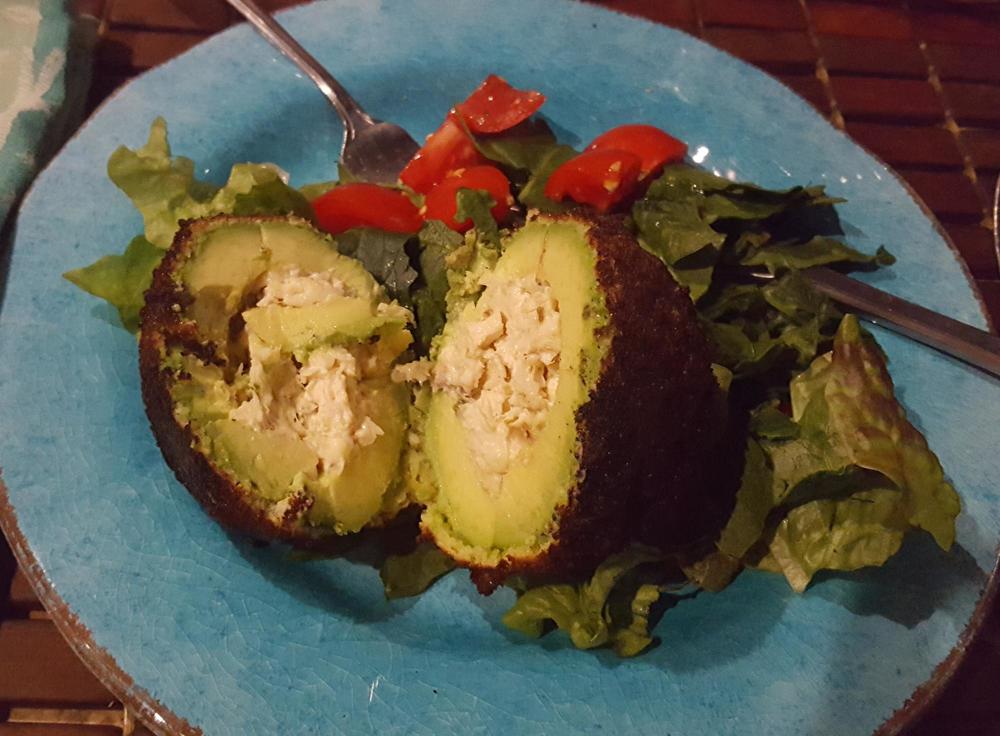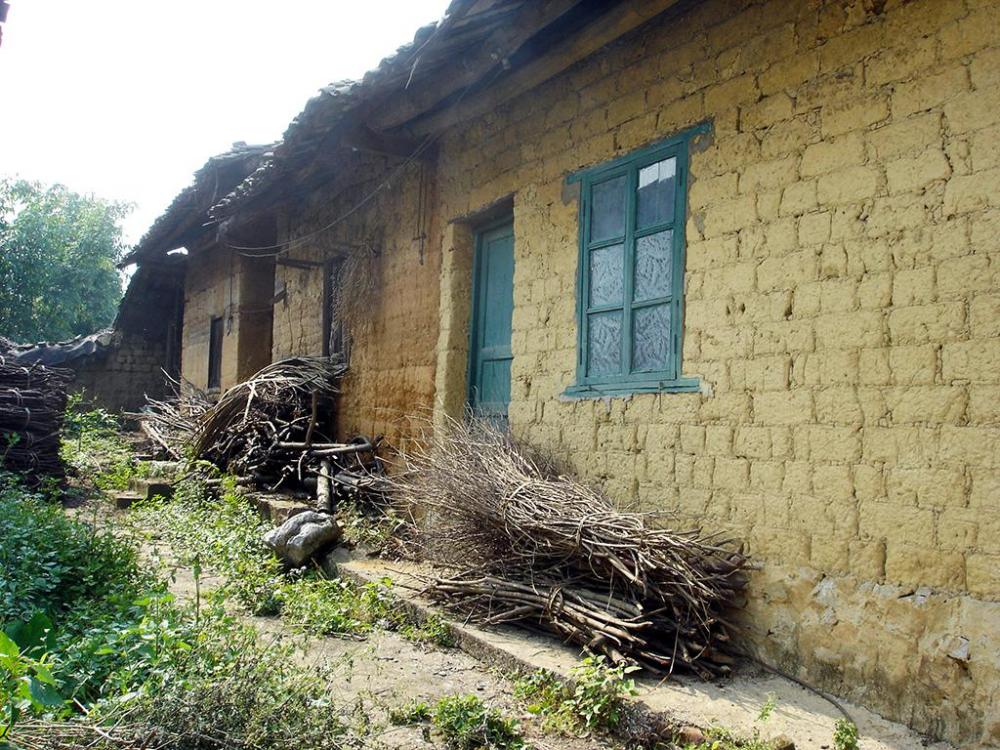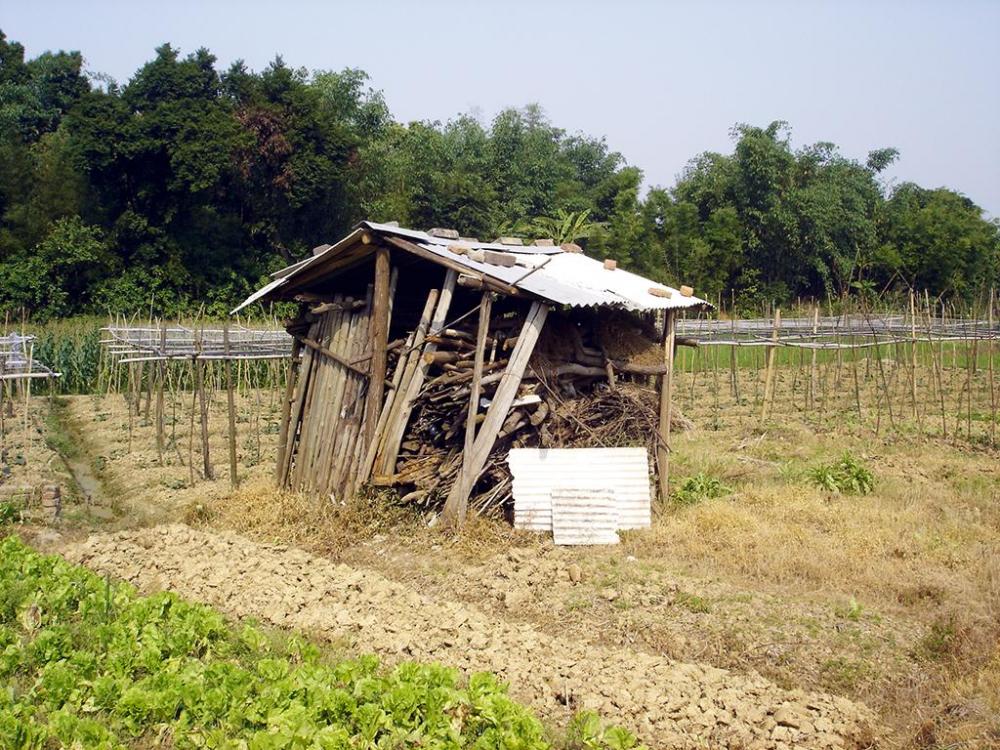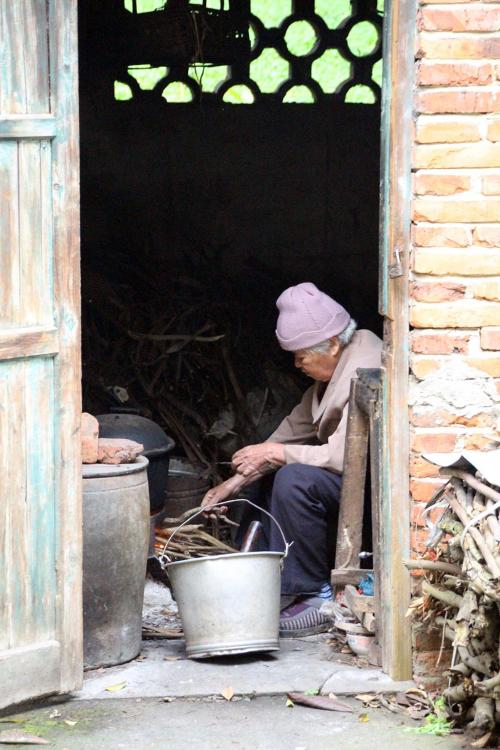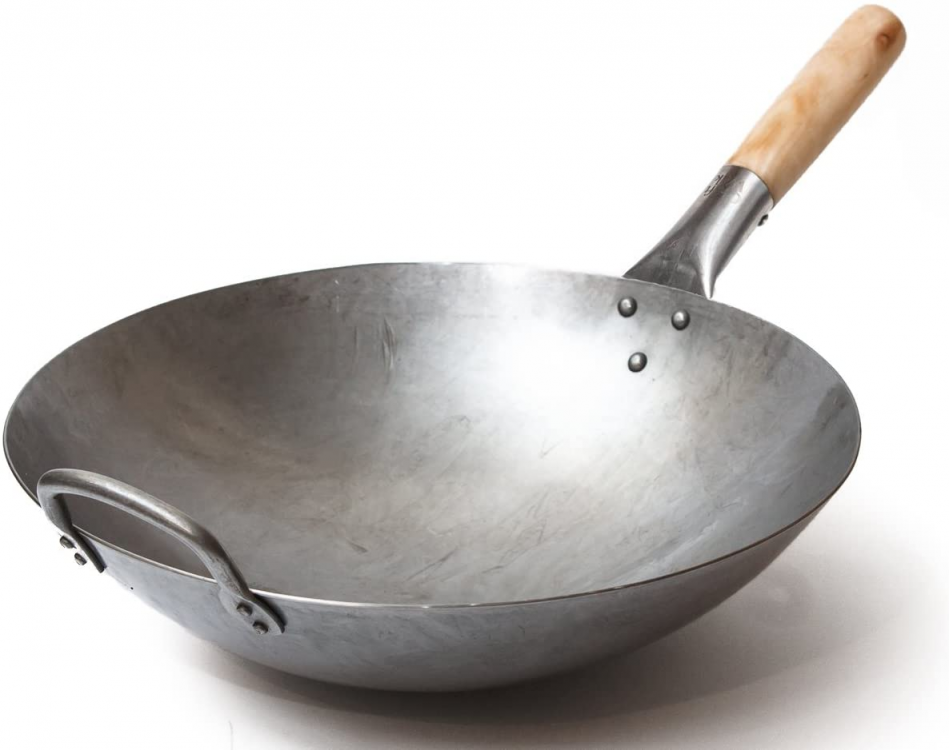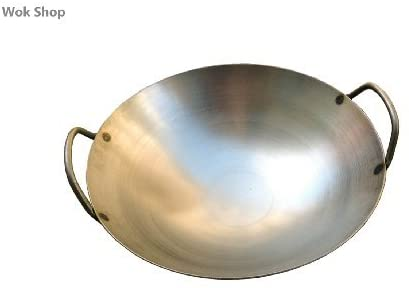Search the Community
Showing results for 'wok'.
-
I'll keep an eye out for another chance to rescue some unwanted leaves. If the chance doesn't come now, I'll look for them next summer. Thanks! It's warm and spring has sprung. It's subtle in the desert, but if you know where to look you can find color. The washes in the evening have a delicate floral perfume that I haven't managed to identify yet. Brittle bush, ocatillo, native trees and fairy dusters The campfire has come into its own, partly so we can enjoy the night sky and partly to keep the trailer cooler. We've been making heavy use of a burger basket, a wok-shaped double basket and Papa's Pan, with an occasional appearance by a cast-iron skillet. Papa's Pan - I've written about it before, here - has given us a new favorite way to cook brussels sprouts. Cut them in half, load them into Papa's Pan with 2 or 3 strips of bacon cut into 1" chunks, drizzle with enough olive oil to provide good pan searing and a hint of balsamic vinegar. Close the pan. Put it over high flame until you hear it sizzling, give a few shakes, flip and repeat, then set it over a warm flame until it's done and the rest of dinner is ready. This method would also work on stovetop, inside an oven or under a broiler - any source of high heat - but over an outdoor fire with an omelet pan there's no mess to clean up when juices drip from the pan, and there's no need to keep stirring with a spoon or spatula. The first night we tried it we added some stray asparagus spears. They didn't suffer from the treatment a bit. That, plus burgers from the basket, and a bit of green salad, were all we needed. My burger fell apart because it stuck to the basket. Guess I needed a bit of oil first. Other campfire dinners: Chicken thighs with a spicy rub, inspired by a recipe from Paula Disbrowe's charming book Cowgirl Cuisine. The beans here are fava beans - my first attempt, and none too impressive. The favas will need more work, but the chicken is always a hit. Numerous grilled-meat and -vegetable dinner salads, like this one: Tequila chicken dinner salad, not yet tossed (above), and served (below). I'll write about pecans and salmon another time.
-
We've been set up for outdoor cooking, with little inclination to actually do it, since we landed in the desert. Oh, there have been a few campfires, with food cooked over them. However, it's been colder or windier than we would like. Compared to almost anywhere else in the country the "colder / windier" bit would be a laugh. We compare it to the comfort of cooking indoors, in the Princessmobile, where we can have a furnace running if need be. Earlier this week we decided it was time. I had some deep-frying to do, and the camp stove was the preferred source of heat. I went to fire it up...and discovered that it had quit working. I couldn't build pressure in the fuel container, because the pump didn't have a good seal. If anyone wants an explanation of how a Coleman camp stove (or lantern) pump works, feel free to ask. Suffice it to say that I know far more than I did, and we got it working without buying spare parts, but the outdoor cooking was put off for a few days. Today, we inaugurated the stove along with the wok I inherited from a dear friend last fall. Joan would have been proud. I wrote about the stuffed, deep-fried avocados in detail, in the eG Avocado Cook-off topic. I think it's worth doing again, with some possible revisions. My darling would always prefer something like the pork roast we've been feasting from for the past 2 weeks, with variations on what to do with the leftovers. But he's happy to see me having fun in the kitchen, and willing to put up with avocados for the cause.
-
im not sure why ovens need firmware. just because firmware exists these days doesn't mean its necessary for everything. CSO woks fine w/o it. remember the camera in the oven ? soy could watch your ' roast 'on an iPhone? I was vey interested in the Anova oven. firmware efforts should have been used for hardware first. Ludite i am these days.
-
A pictorial guide to Chinese cooking ingredients
dmreed replied to a topic in China: Cooking & Baking
I read in one of my cookbooks, that this is the way to order it if one wants to check out the wok expertise of the chef! I have yet to try it because none of the restaurants have had it...so I ordered Chinese Brocolli plain instead. Apparently I will have to buy some choy sum and cook it myself. -
A pictorial guide to Chinese cooking ingredients
dmreed replied to a topic in China: Cooking & Baking
but what I what is choy sum without garlic...just oil and salt! what would be the name and the Chinese characters. BTW I got my original name from a cookbook and it said that this was the best way to test the wok hay capabilities of the chef. -
A pictorial guide to Chinese cooking ingredients
dmreed replied to a topic in China: Cooking & Baking
Yow Yim Choy Sum I would like to have the Chinese characters for one of my favorite dishes, Yow Yim Choy Sum, which I now order to check the quality of the cooking especially the wok hay when I visit a Chinese restaurant for the first time. so far, I have had to specifically order the dish as "plain" rather than with garlic or oyster sauce so I would appreciate any further Chinese characters which specify "plain", i.e., just salt and oil! -
A pictorial guide to Chinese cooking ingredients
dmreed replied to a topic in China: Cooking & Baking
Chinese characters: TEEM for SWEET: 甜 SEEN for SOUR: 酸 HEONG for pan-flavor: 香 (I think this is what you were referring to) WOK HAY: 鑊氣 (I bought a hand-writing Chinese input device. Entering Chinese characters is much easier now. ) - 阿梁 thanks...are the above Mandarin, Cantonese??? Really nice to see you are still here!!!!!! how about the remaining flavors: HOM like salt FOO from very slightly bitter to very bitter TOM like rice or the "baked" flavor of bread LOT like in mustard or chili peppers GUM cool, acrid-sweet like citrus peel -

A pictorial guide to Chinese cooking ingredients
hzrt8w replied to a topic in China: Cooking & Baking
Chinese characters: TEEM for SWEET: 甜 SEEN for SOUR: 酸 HEONG for pan-flavor: 香 (I think this is what you were referring to) WOK HAY: 鑊氣 (I bought a hand-writing Chinese input device. Entering Chinese characters is much easier now. ) - 阿梁 -
A pictorial guide to Chinese cooking ingredients
dmreed replied to a topic in China: Cooking & Baking
there are Chinese names for flavors and tastes such as TEEM for SWEET, SEEN for SOUR, HEONG for pan-flavor or WOK HAY, etc. using soy sauce and other fermented soy products, I know the Chinese are aware of the Japanese flavor called UMAMI but what is the Chinese name for this flavor? -

China Sichuan Cuisine (in Chinese and English)
Burmese Days replied to a topic in China: Cooking & Baking
Ladies and gentlemen, ... It arrived! I ended my last post reflecting on all the effort it took to find this book. I acknowledged that in all likelihood, this book would not be worth the work. I'm happy to say I was wrong. This book is a wonderful find, and I hope all of you get the chance to enjoy it one day. The most interesting part of all is this the recipe layout. I've never seen such cleanly outlined recipes. For the sake of an example, here's the Mapo Tofu recipe from the book. As the colloquial Sichuan dish in the West, it should be a good point of reference for many that read this post. Here's a transcription - Ingredients 300g tofu, 60g stir-fried beef mince, 20g baby leeks (chopped into sections), 80g cooking oil Seasonings A 25g Pixian chili bean paste, 10g ground chilies, 6g fermented soy beans Seasonings B 3g salt, 5g soy sauce, 1g MSG Seasonings C 1g ground roasted Sichuan pepper, 200g everyday stock, 30g cornstarch-water mixture Preparation 1, Cut the tofu into 1.8cm3 cubes, blanch in salty water, remove and soak in water. 2. Heat oil in a wok to 120°C, add Seasonings A and stir-fry to bring out the aroma. Add the stock, fried beef mince, season with Seasoning B, and simmer for 2 to 3 minutes; add the leeks and thicken with cornstarch-water mixture; Transfer to a serving bowl and sprinkle with Seasoning C. So a lot to go through here. I'm going to split up my comments and critiques into two categories. One that critiques the recipe and one that critiques the recipe layout/choices. Comments on the recipe Beef Everything about the beef was a little strange in this dish. They called for the beef pre-cooked and didn't go over the cooking step at all. While this would normally be fine all though a little strange, in mapo tofu, it's bad. The whole point of the beef is to use the fried beef oil as the base for the dish. The mince itself is tertiary. Because the recipe never outlined cooking the beef, the average home cook would most likely not realize that they needed to save the oil for cooking the Pixian bean paste. Aromatics The first thing I noticed when I read this recipe was that it had no aromatics besides the Sichuan pepper powder if you count that. No garlic. Not even the white portion of the green onion. This struck me as strange till I looked a little deeper at what the hell "baby leeks" are in this context. Welcome to the wacky world of obscure vegetables and aromatics. Where scientific names are never listed, and regional names differ wildly. Were they calling for Dacong, aka welsh onion (Allium Fistolum)? It's very often used across Northern China Is it talking about actual leeks (Allium ampeloprasum)? Or perhaps it meant Chinese chives, aka garlic chives (Allium tuberosum). No, this has nothing to do with garlic, garlic scapes, or green garlic besides the fact that its an allium. Speaking of garlic, it could be green garlic; immature garlic pulled before the bulb has matured (Allium sativum). It looks quite like a large scallion. Possibly it's garlic scapes, the immature flower stalks of garlic (Allium sativum). They're often removed by farmers to focus all the garlic's energy into bulb growth. Because of this, they're plentiful and cheap across China. I can come up with at least five more, but I think you get the point The characters listed for it are "蒜苗节20克". From my limited google skills, I've come to the conclusion that they're suanmiao, aka green garlic. A good sub if you can't find any in your area is... well... garlic. I'd add it right after you finish frying seasonings A but before you add the stock. 10-15 seconds should be enough time for it to cook. While you'll miss a lot of the pleasent textural aspects, and the garlic flavor will be more homogeneous in the dish, it should work pretty well as far as subs go. If you take anything away from this, know that dacong are not leeks, no matter how often they're translated as leeks in the West. They both taste similar, but dacong is tender and soft while leek can be tough and crunchy. Dacong closer to a scallion than an onion in flavor, unlike leek. Also, Chinese leek can refer to dacong, leeks, and Chinese Chives - so be careful with that term. This is why sources like liuzhou's Chinese Vegetables Illustrated thread are so important. So after that detour, back to the recipe. Critiques of the recipe layout and recipe choices Seasoning categories The seasonings categories are a brilliant idea. It's the linchpin of what makes these recipes so concise and neat. It makes perfect sense when you think of most wok cooking. A basic fried rice or stir-fry are cooked very fast. The timing between adding different types of ingredients is crucial and can be a surprisingly narrow range. Take a look at this basic gailan stir-fry. I've listed estimated cooking times for each step. Quick fry of the beef and remove ~45 seconds Fry the garlic and ginger~ 10seconds Throw in onion and chili ~30 seconds Splash of Shaoxing wine Toss in the (mostly) cooked beef ~15 seconds Add soy sauce Quick mix ~10 seconds Add cornstarch slurry Quick mix ~10 seconds Add blanched gailan Quick mix ~10 seconds Drizzle with some toasted sesame oil You can see that once you start, it's a very fast process. This leaves the cook with very little time to fiddle with their recipe books and even less time to deliberate over what to do. Compare that to this version of the recipe, which consolidates each ingredient type into categories. Ingredients - Beef slivers, blanched gailan Seasonings A - ginger, garlic seasonings B - onion, chili Seasonings C - soy sauce, cornstarch slurry Quick fry of the beef and remove ~45 seconds Fry the seasonings A ~10seconds Throw in seasonings B ~30 seconds Splash of Shaoxing wine Toss in the (mostly) cooked beef ~15 seconds Add Seasoning C Quick mix ~10 seconds Add blanched gailan Quick mix ~10 seconds Drizzle with some toasted sesame oil While it may arguable be a longer recipe, it feels neater. It takes steps away from the frantic parts of the cooking process and places them at the start, where you have all the time in the world. It forces the cook to create a form of mise en place. Of course, a good cook can use both recipes perfectly well and make great food. But to someone like me, who does not prepare well enough ahead of time while cooking, the second recipe is inarguable better. While the idea may be brilliant, the execution is less than perfect. For example, 2 out of three of the ingredients in seasonings C are used before seasonings C is called for. There is no need for a whole category when you're just going to list for the ingredients individually anyway. Measurements As you can see, the measurements are all given in grams. I can't count how many cups vs. grams arguments I've read on forums, but I can tell you this is the first truly grams only cookbook I own. Instead of a teaspoon, it calls for things down to a single gram's worth. I'm not sure how I feel about this. I greatly prefer grams to cups, but for sums smaller than 5 grams~ volume just seems better. I'm willing to be wrong, though, and I'm excited to try this book out. I might need to get a scale with better resolution. Conclusion I'm very excited to use this book more. I showed the mapo tofu recipe as a point of refrenece for everyone, but this book has much more to it than just mapo tofu. There are so many interesting recipes that I'm excited to try. I'll update this thread if I make anything else fro the book. -
21. "the Chinese home cook crouched over a wok on a brazier fed with twigs and cow chips" When I first came to live in China in 1996, it was said that 80% of the population was rural and 20% lived in cities. Today, we are told it’s the opposite, but while certainly many people, especially the younger generations, have moved to cities, it is often only temporarily. Many have become migratory workers, travelling to wherever the work is and moving on when the work moves on. Most of these end up working in the coastal areas in the east and south-east of the country. Also, many of these, men and women, have children whom they leave behind with the grandparents while sending money back. Many of these people fully intend returning home; many already have. As China’s economy has grown incredibly over the last couple of decades, its reputation as a source of cheap labour has correspondingly diminished and the large foreign companies are looking for other places to exploit instead. The Chinese government has thrown billions of hard cash into developing the interior and western regions, so reducing people’s dependence on migratory work. But for sure the number of city dwellers has risen considerably and, in general, people are more affluent. This new affluence has, of course, led to a rise in living standards and a new middle class. They demand everything new. There is very little demand for second-hand cars and I have never seen the type of second-hand shops which are common elsewhere. I can only think of one second-hand store here in town and that is a second-hand cell phone outlet. And it’s the same with housing. The new middle class only want newly built homes. These they buy unfinished and then arrange to have builders in to finish the interior layout to their own specifications. Even those who do buy pre-owned homes do the same, ripping out interior walls, plumbing etc and rebuilding the interior. They call this ‘decorating’. And of course, this extends to the kitchens. Chinese domestic kitchens tend to be on the small side and have little storage space compared to western kitchens. Most people cook on one of these. So, do I. I’ve never seen anything resembling a western stove. They may have a microwave, but that is mostly used for heating up dishes that have cooled down a bit. A rice cooker, for sure. And often a pressure cooker. No oven. This is my kitchen as it was on the day I moved in. There is another counter and more storage space on the other wall, too. I didn't rebuild anything. The thing on the left of the counter near the window is an infra-red or UV steriliser for bowls and plates etc. I moved it. This is not the most luxurious, but better than many. So, although the kitchens may be more modern looking, they still generally contain the same limited equipment. Not that the Chinese consider there to be any limitations. They have what they need. Out in the countryside, in many places, the “wok on a brazier fed with twigs and cow chips” tradition lingers but is becoming rarer and rarer. Except it wouldn’t just be twigs. And no cow chips. There aren’t that many cows in China. (I had to look up ‘cow chips’; not an expression I’ve heard, though I did guess the meaning.) That said, yak dung is used for fuel in Tibetan areas. Most of these home cooks would use wood, which they gather throughout the year and store for future use. Firewood stack The hut is firewood too I think! This old lady was cooking her lunch over a pile of firewood in a metal bucket in a sort of outhouse. As to what people cook, I don't think the new-found affluence has changed much, other than people eat more of the same. More meat, for sure, but still prepared in the traditional ways. Despite the oft-repeated claims that the Chinese eat everything (another myth), I find most people to be rather on the conservative side in terms of what they will eat and, especially, cook. I’d estimate that 90% of the restaurants here in Liuzhou are serving either local cuisine or dishes which have been well-known all over China for a very long time. When I lived in Hunan, it was the same. Restaurants did Hunan food. We do have a few restaurants serving other region’s cuisines in town, but I don’t think many people would be cooking those dishes at home. I know my friends never do. Even in places like Beijing and, even more so, Shanghai, which have restaurants serving food from all over China and the world, few people will be making that at home. For a general idea of what people cook at home I can recommend Fuchsia Dunlop’s Every Grain of Rice: Simple Chinese Home Cooking (eG-friendly Amazon.com link), which covers many of the dishes cooked regularly across China. Regional cookbooks are hard to find, even in Chinese. I have a couple on Sichuan cuisine, but that’s it. I suspect this reply to @Tropicalsenior's question may raise even more questions. If so, please fire away!
-
I think that the perception of most of us in the western world is of the Chinese home cook crouched over a wok on a brazier fed with twigs and cow chips. With the advances that China has made I suppose that many home cooks have kitchens that resemble those in the West. Just as their style of cooking has to have changed, has the type of food that they are cooking changed? With the transport and availability of food from other regions, has it caused them to be less regional in their home cooking?
-
When I purchased my first wok, way back in the previous century (okay, 1977 or so), I don't even think they offered one-handled ones. I only remember seeing the two loop handles, carbon steel. But I could be misremembering.
-
Please correct me if I'm wrong, but I'd assume that the 2 loop handled wok is mainly used for deep frying, boiling or steaming. Unless the wok is HUGE, in which case it's not going to be picked up to toss the food anyway - in which case the two loop handles would be fine for stir frying since really they just stay out of the way until you want to move the wok to a new location.
-
I don't think it's exactly a myth about needing high BTUs, but more heat is better. I cooked for many years with a wok on a so-so average stove and it was okay, but then I got a Viking. The flame is big, although I would have to go through stacks of old manuals to locate the original specs re the BTUs. The stove has heavy cast iron grates and I have an optional cast iron wok grate that I can switch in as needed. Clearly I'm not getting the kind of heat they get in commercial wok kitchens, but my wok gets hotter than on any other stove I've ever used, and that seems to be a good thing. The wok is carbon steel, relatively heavy, with one long wooden handle. The ones with two short loop handles don't seem very practical, but I suppose it's about what you are used to. Don't those handles get awfully hot? I purchased mine when I lived on the edge of SF Chinatown about forty years ago and I use it at least once a week. I think of it as being a very typical round bottom shape. No longer lovely, but at this point it hasn't changed its venerable look for years. I hope it lasts the rest of my life.
-
Well, my ocular talents are on a level with yours. One day I'll go back and check, but it's not a part of town I normally frequent. Most people, in my experience, do use the long handled style. Both my woks are so designed. It tends to be called the Beijing style. I forget what the other kind with two loops is called - the impractical kind?
-
Now you're really confusing me! Looking more closely, maybe it's just a sort of frying pan? Does anyone use the one handled wok at home, or are they all pretty much with the two loop handles?
-
The red handled things aren't woks. I forget what they are but not woks.
-
The shape of wok worked well with old technique of thin cast iron making as well as hand making. Long time ago when I was visiting China, I have seen how steel wok making with using only one tool, a hammer. workers could shape a round disk of steel into a wok quickly without years of experience. Interestingly, the wok shape also worked perfectly with old irregular shaped clay wood fired stoves or any shaped coal, charcoal stoves. It always stayed level for cooking. Truly "Form Follows Function." (FFF), "Less Is More". dcarch
-
Actually, you can. I have done so, just not stir-fried. As I said, you can cook almost anything in it. 95% of the lunches and dinners I post here are wok-cooked. Chinese, Italian, Middle-Eastern, British, French, Indian, Greek et al.
-
Yea, I don't get the allure of the wok blaster for the home cook. I put it in the impractical and unnecessary bragging rights category. More important to have a decent wok that can handle and distribute heat evenly.
-
Ming Tsai of Simply Ming ( PBS ) and several local restaurants very very good ones had an Induction Hob for a special Wok on one of his early seasons of " Simply Ming. he has also cooked in a few Chinese Restaurants in China on those massive extremely hot rest.woks. he only used the induction wok set up a few times. I could tell the wok got very very hot the hob was concave and perfectly fit the wok that was pared to it. Im guessing he took it off the show as " Viewers like You " were never going to get one for their home kitchen cost i believe at the time for the set up : 10 - 15,000 USD. plenty of hei for 15 K !
-
I will openly admit to buying into the myth about a wok needing high BTUs. Just putting my brain into gear should have dismissed the myth as logically unlikely outside of a restaurant setting. But apparently I didn’t take the time to think it through. It is regrettable because otherwise I might have used my wok much more frequently. It always struck me as an extremely well designed implement. Don’t do much cooking anymore so my wok is acquiring a lovely patina of dust. But I still have it so who knows.
-
Also, to echo @liuzhou, since it was brought up - in all the food I ate in Sichuan, nothing had that Canto-tasting "wok hei" and pretty much every dish I ate wouldn't require a high-octane burner.
-
So...does every stir fry taste porky? I'm used to using peanut oil exclusively. For a stir fry sauce I might add a bit of pork or ham broth or chicken broth depending on what's in the wok.


